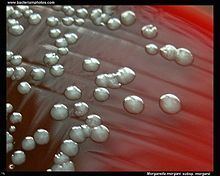Order Enterobacteriales Tribe Proteeae Higher classification Morganella | Family Enterobacteriaceae Scientific name Morganella morganii Rank Species | |
 | ||
Genus MorganellaFulton, 1943 Similar Providencia, Citrobacter, Proteus, Enterobacter, Citrobacter freundii | ||
Medical vocabulary what does morganella morganii mean
Morganella morganii is a species of Gram-negative bacteria. It has a commensal relationship within the intestinal tracts of humans, mammals, and reptiles as normal flora. Although M. morganii has a wide distribution, it is considered an uncommon cause of community-acquired infection and it is most often encountered in postoperative and other nosocomial infections such as urinary tract infections.
Contents
- Medical vocabulary what does morganella morganii mean
- Historical identification and systematics
- Microbiology
- Role of bacteria
- Treatment and antibiotic resistance
- References
Historical identification and systematics
Morganella morganii was first described by a British bacteriologist H. de R. Morgan in 1906 as Morgan's bacillus. Morgan isolated the bacterium from stools of infants who were noted to have had "summer diarrhea". Later in 1919, Winslow et al. named Morgan's bacillus, Bacillus morganii. In 1936, though, Rauss renamed B. morganii as Proteus morganii. Fulton, in 1943, showed that B. columbensis and P. morganii were the same and defined the genus Morganella, due to the DNA-DNA hybridization. M. morganii has two subspecies – M. m. morganii and M. m. columbensis. However in 1962, a review article by Ewing reported that M. columbensis had been reidentified as Escherichia coli, therefore removing that organism from the genus., Morganella.
Microbiology
Morganella morganii is facultatively anaerobic and oxidase-negative. Its colonies appear off-white and opaque in color, when grown on agar plates. M. morganii cells are straight rods, about 0.6–0.7 µm in diameter and 1.0–1.7 µm in length. This organism moves by way of peritrichous flagella, but some strains do not form flagella at 30 °C.
M. morganii can produce the enzyme catalase, so is able to convert hydrogen peroxide to water and oxygen. This is a common enzyme found in most living organisms. In addition, it is indole test-positive representing this organism can split tryptophan to indole, pyruvate, and ammonia. Methyl red tests positive in M.morganii, an indicator dye that turns red in acidic solutions. Although a rare human pathogen, M. morganii has been reported as a cause of urinary tract infections, nosocomial surgical wound infections, peritonitis, central nervous system infection, endophthalmitis, pneumonia, chorioamnionitis, neonatal sepsis, pyomyositis, necrotizing fasciitis, and arthritis. Numerous cases of nosocomial infection have been described, usually as postsurgical wound infections or urinary tract infections. Patients in whom bacteremia develops are typically immunocompromised, diabetic, or elderly, or have at least one serious underlying disease.
Role of bacteria
M. morganii is a member of the tribe Proteeae (normal fecal flora that often causes infection in patients whose normal flora have been disturbed by antibiotic therapy) of the family Enterobacteriaceae, with two species: M. morganii and M. sibonii. M. morganii has been regarded as a harmless opportunistic pathogen, but some strains carry "antibiotic-resistant plasmids" and have been associated with nosocomial outbreaks of infections. Several reports indicate M. morganii causes sepsis, ecthyma, endophthalmitis, and chorioamnionitis, and more commonly urinary tract infections, soft tissue infections, septic arthritis, meningitis, and bacteremia, often with fatal consequences.
In a rare case published in 2003, a patient presented with bilateral necrosis of both upper and lower eyelids. Upon microbial analysis, the areas were shown to have heavy growth of M. morganii.
Treatment and antibiotic resistance
Treatment of M. morganii infections may include:
A study conducted at the University Hospital at Heraklion, Crete, Greece showed a 92% success rate in the use of these antibiotics.
However, some M. morganii strains are resistant to penicillin, ampicillin/sublactam, oxacillin, first-generation and second-generation cephalosporins, macrolides, lincosamides, fosfomycin, colistin, and polymyxin B. The emergence of highly resistant strains of M. morganii have been associated with use of third-generation cephalosporins.
Polymicrobial infections are most abundantly caused by this microbe which additionally damages the skin, soft tissues, and urogenital tract; these can be cured through use of the aforementioned antibiotics.
